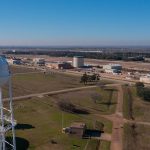
Last Energy, Texas A&M Collaborate to Launch Microreactor Pilot at Texas A&M-RELLIS
The project secures land, fuel and Department of Energy pathway for scaled nuclear demonstration.
The City of Bryan’s Water Services is working diligently to identify city- and privately-owned service lines as required by the U.S. Environmental Protection Agency’s (EPA) updated Lead and Copper Rule Revisions (LCRR). This federal mandate requires all community water systems to identify and replace lead service lines within the next 10 years.
An initial inventory of Bryan’s 36,446 water service lines was completed through a review of designs and plans. The results are as follows:
There is no indication of lead issues in Bryan’s water supply.
Letters have been mailed out to customers whose water line has an unknown material status. Water Services has also created an online inventory map where customers can enter their address to view the classification status of their water line.
Customers who received an unknown status and know their water line material, either from a repair or replacement, are asked to complete this survey.
Water Services staff will be conducting field investigations by digging small holes near the meter box to physically identify the line material. If a lead or galvanized line requiring replacement is found, staff will notify the customer immediately and advise on next steps. Note that, the city’s line runs from the water main to the meter box and the private side runs from the meter box to the home/business.
The inventory process will continue until all water service lines have been identified.
Congress passed the Safe Drinking Water Act in 1986 banning the use of lead piping and it was banned in Texas in 1988. The EPA adopted the Lead and Copper Rule in 1991 and the revision was adopted on Oct. 8, 2024.
Water Services has tested for lead since 1994. Historically, lead levels have been below actionable thresholds, with a range of 1.5 to 2 parts per billion (ppb). The recent LCRR update lowered the actionable threshold for lead from 15 ppb to 10 ppb.
Lead can enter drinking water when pipes and plumbing fixtures containing lead corrode, particularly in water with high acidity (a pH of 6.5 or less). Bryan’s water has a pH of 8.3-8.5, which reduces the risk of corrosion.
If you are concerned about lead exposure, here are some steps to take:
If you have any questions or concerns, please email PWCC@bryantx.gov or call 979-209-5900.